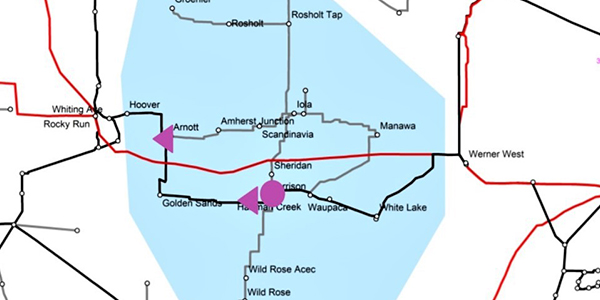By Amanda Durish Cook
An American Transmission Co. effort to improve reliability in central Wisconsin could within two years provide MISO with its first-ever storage-as-transmission asset (SATA) project.
ATC is proposing to build a 2.5-MW/5-MWh battery on a 138-kV line in the Waupaca, Wis., area, installing two capacitors and upgrading a nearby 69-kV bus to accommodate the project. The project would cost an estimated $9.1 million and be in service at the end of 2021. ATC said the battery would be available for two-hour discharge times.
The company is proposing the project for inclusion in MISO’s 2019 Transmission Expansion Plan (MTEP 19) to function as strictly transmission. MISO is so far prohibiting SATA projects from also providing market services. (See MISO Limits Storage as Transmission Asset Ownership.)
During a West subregional planning meeting Friday, MISO staff said the project still requires study, including determining how it could impact load service risks and system reliability. The RTO said it will present final project justification results at another subregional planning meeting on Aug. 23.
The company has also submitted two alternatives — another battery farther north and a traditional wires solution — in the event that MISO finds negative impacts from the originally submitted battery format. The 5-MW/10-MWh alternate battery project would cost $10.4 million, and a rebuild of the Whiting Avenue-Hoover 115-kV would cost $12.4 million. Both would stick to a late 2021 timeline.
ATC said its preferred battery project is designed to more reliably maintain up to a 155-MW load level, capturing more than 90% of historical load levels in the Waupaca area. The area is currently at risk during multiple outage conditions, MISO expansion planner James Slegers said.
“At certain load levels, the system cannot sustain the load,” Slegers said.
Waupaca contains a local 69-kV system supported by a nearby multi-segment 115/138-kV transmission line. MISO said local loads cannot be sustained when both ends of the 115/138-kV supply line are out of service. ATC currently uses an operating guide to open line segments to serve load radially on the 69-kV system after load levels reach a certain point and after a first outage. While the operating guide allows loads to be served after a second contingency, it places up to 114 MW of load at risk of disconnection, according to MISO. ATC’s battery is designed to operate after a second contingency.
“There are not many hours in a year that you could take a maintenance outage and not sectionalize the system,” Slegers said, adding the solution aims to allow multiple maintenance outages without a loss-of-load risk.
MISO has completed a reliability assessment on the battery project. So far, it found the most effective siting of a SATA solution is near the Harrison 69-kV substation in the area, although other nearby 138-kV buses between Arnott and Waupaca “performed similarly well.”
MISO Manager of Expansion Planning Lynn Hecker said the RTO has so far been using a conservative, approximately 20-year life cycle assumption in battery reliability studies.
The RTO has yet to develop life cycle cost comparisons for ATC’s battery and alternate projects.
Slegers said MISO is open to studying even more project alternatives, if stakeholders offer them. The RTO has said it will work with stakeholders “to understand technical details and evaluate any additional alternatives proposed.”
He noted that the ATC project evaluation will serve as a starting point and “lessons learned” for other SATA projects proposed in future MTEP cycles.



